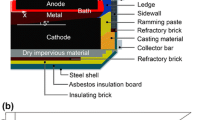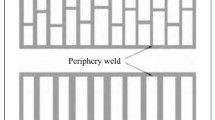Abstract
The ultimate life of an aluminum reduction cell cathode is dependent on the thickness of the carbon above the collector bars and the erosion rate of the carbon. By measuring the erosion rate and knowing the thickness of the carbon above the collector bars, plants can determine their ultimate potlife. However, few cathodes fail due to erosion on a regular basis; other determinants affect potlife. Cathode design and the cell operation are both equally important in determining cathode life.
Similar content being viewed by others
References
Hall-Héroult Centennial: First Century of Aluminum Process Control, ed. W.S. Peterson and R.E. Miller (Warrendale, PA: TMS, 1986), p. 8.
J.M. Peyneau, “Design of Highly Reliable Pot Linings,” Light Metals 1989 (Warrendale, PA: TMS, 1989), p. 175.
E.W. Dewing, “Longitudinal Stress in Carbon Lining Blocks Due to Sodium Penetration,” Light Metals 1974 (Warrendale, PA: TMS, 1974), p. 879.
Kaiser Aluminum, internal documents regarding shell strength at the Chalmette, Louisiana plant.
R.L. Rolf and R.W. Peterson, “Compressible Insulation to Reduce Potlining Heaving in Hall-Heroult Cells,” Light Metals 1987 (Warrendale, PA: TMS, 1987), p. 209.
R. Fourcault and B. Samanos, 2nd Australasian Smelter Technology Course, Sydney, 1987.
M. Sorlie and H. Øye, “Laboratory Testing of Cathode Carbon Materials at Operational Temperatures,” Light Metals 1989 (Warrendale, PA: TMS, 1989), p. 625.
M.B. Rapaport and V.N. Samoilenko, “Deformation of Cathode Blocks in Aluminium Baths During Process of Electrolysis,” Tsvetny Met. 30 (1957), p. 44.
D.V. Stewart and A.T. Tabereaux, “Evaluation of Castable Refractory Barriers Reduction Cell Cathode,” Light Metals 1989 (Warrendale, PA: TMS, 1989), p. 153.
I. Letizia and C. Bizzarri, Proc. Int. Conf. Aluminium, New Delhi (1985), p. 141.
Kaiser Aluminum, internal communication.
C.H. Clelland, J.T. Keniry and B.J. Welch, “A Study of Some Aspects of the Influence of Cell Operation on Cathode Life,” Light Metals 1982 (Warrendale, PA: TMS, 1982), p. 299.
General Reference
M. Sorlie and H. Øye, Cathode in Aluminium Electrolysis (Düsseldorf: Aluminium-Verlag GmbH, 1989).
Author information
Authors and Affiliations
Rights and permissions
About this article
Cite this article
Hale, W.R. Improving the useful life of aluminum industry cathodes. JOM 41, 20–25 (1989). https://doi.org/10.1007/BF03220379
Issue Date:
DOI: https://doi.org/10.1007/BF03220379




